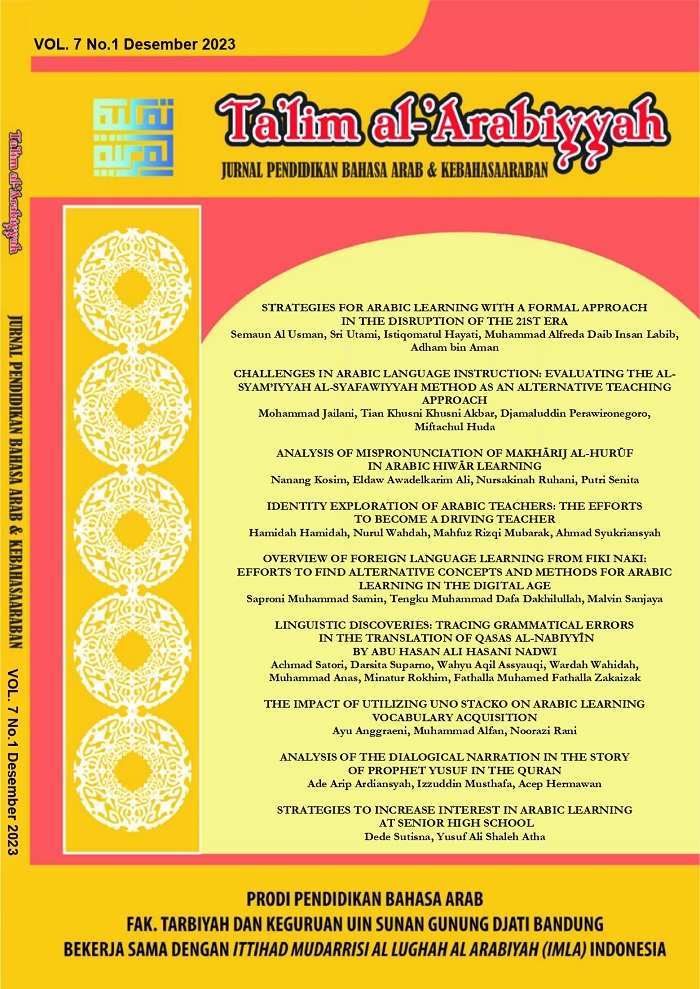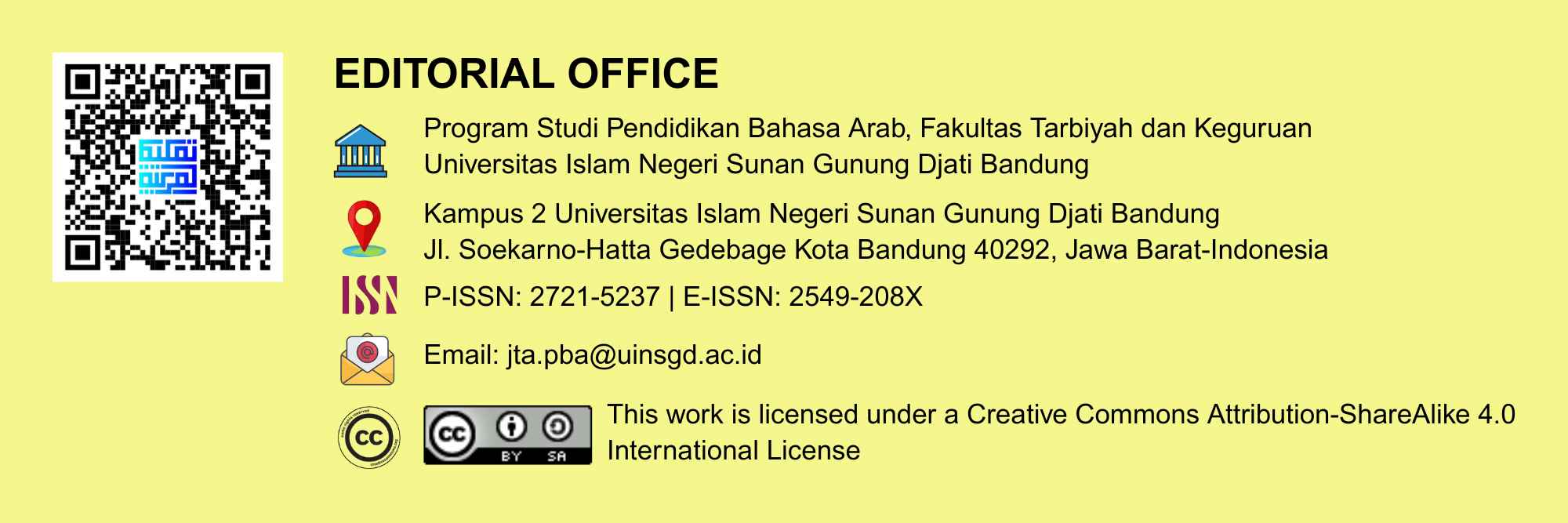Challenges in Arabic Language Instruction: Evaluating the Al-Syam’iyyah Al-Syafawiyyah Method as an Alternative Teaching Approach
DOI:
https://doi.org/10.15575/jpba.v7i2.23618Keywords:
Arabic Learning, Al-Syam'iyyah Al-Syafawiyyah, Evaluating, Learning MethodAbstract
The prevailing issues in education have shown that schools and teachers have struggled to implement effective Arabic learning methodologies. While teachers comprehend various teaching approaches, these methods are often ineffective for students. This study aimed to analyze the effectiveness of the al-sam'iyyah al-syafawiyyah learning method in teaching Arabic at SMK Muhammadiyah 3 Yogyakarta. The research used a qualitative method to involve teachers and students within SMK Muhammadiyah 3 Yogyakarta. Data collection methods included interviews, observations, and documentation. The analysis followed Miles and Huberman's data display, reduction, and verification techniques. Triangulation was utilized to fortify the research data from fieldwork and primary sources (literature). The study revealed significant disparities between the al-sam'iyyah al-syafawiyyah method and the conventional teaching approaches practiced by teachers at the school. According to teacher feedback, the predominant method used thus far has been lecturing, resulting in 60% of students not mastering the 'mufradÄt.' Conversely, the implications of the al-sam'iyyah al-syafawiyyah method indicated highly engaged, active, and practical students. This method primarily focuses on enhancing student concentration through listening, imitating teacher explanations, and practicing the fluency of 'mufradÄt.'
References
Aflisia, N., Erihadiana, M., & Balqis, N. (2020). Teacher’s Perception Toward the Readiness to Face Multiculturalism in Arabic Teaching and Learning. Izdihar : Journal of Arabic Language Teaching, Linguistics, and Literature, 3(3), 197–210. https://doi.org/10.22219/jiz.v3i3.14117
Al-Amery, A. M. H. (2020). Attitudes of the Students at the Institutes of Fine Arts in Iraq Towards Implementing Active Learning Strategies in Arabic Language Courses and the Associated Challenges. Journal of Education and Practice, 11(13), 73–81. https://doi.org/10.7176/JEP/11-13-08
Al-Ayubi, S. Y., Putra, S., & Mokodenseho, S. (2023). Penggunaan Metode Audiolingual dalam Maharah Istima’di Madrasah Tsanawiyah Al-Kahfi Hidayatullah Surakarta. Journal of Education Research, 4(4), 1839–1845. Retrieved from https://jer.or.id/index.php/jer/article/view/530
Aprianto, A., Ritonga, M., Marlius, Y., & Nusyur, R. (2020). The Influence of Using Audio-lingual Method on Students’ Speaking Skill in Madrasah Diniyah Takmiliyah Awwaliyyah. Izdihar : Journal of Arabic Language Teaching, Linguistics, and Literature, 3(2), 147–160. https://doi.org/10.22219/jiz.v3i2.12514
Fauzi, N. A. F., & Ayub. (2019). Fikih informasi: Muhammadiyah’s Perspective on Guidance in Using Social Media. Indonesian Journal of Islam and Muslim Societies, 9(2), 267–293. https://doi.org/10.18326/ijims.v9i2.267-293
Hermawan, A. (2018a). Metodologi Pembelajaran Bahasa Arab (Edisi Revisi). Remaja Rosdakarya.
Hermawan, A. (2018b). Pembelajaran Keterampilan Berbahasa Arab dengan Pendekatan Komunikatif – Intraktif. Alfabeta.
Huneety, A., Mashaqba, B., Al-Quran, M., & Hishma, J. (2020). Stress production by Cebuano learners of Arabic: A metrical analysis. Indonesian Journal of Applied Linguistics, 9(3), 517–525. https://doi.org/10.17509/ijal.v9i3.23201
Jailani, M. (2022). Development of Arabic Learning Media Innovation from Neuroscience Perspective for Santri: Implications in the Development of Intellectual Property Rights in Islamic Boarding Schools. Al-Talim Journal, 29(2), 150–163. https://doi.org/10.15548/jt.v29i2.734
Jailani, M., & Huda, M. (2022). Implementation of Neuroscience-Based Multiple Intelligences Theory: To Improve the Intelligence of Students in Ma’had. Jurnal Al Bayan: Jurnal Jurusan Pendidikan Bahasa Arab, 14(2), 345–362. https://doi.org/10.24042/albayan.v14i2.12211
Jailani, M., Wantini, W., Suyadi, S., & Bustam, B. M. R. (2021). Meneguhkan Pendekatan Neurolinguistik dalam Pembelajaran: Studi Kasus pada Pembelajaran Bahasa Arab Madrasah Aliyah. Jurnal Pendidikan Agama Islam Al-Thariqah, 6(1), 151–167. https://doi.org/10.25299/al-thariqah.2021.vol6(1).6115
Mamnunah, M., Syihabuddin, S., & Nurbayan, Y. (2021). Policy Implementation of the Sabilillah Spectacular Stage (Sss) Program to Increase Students’ Speaking Skills. Arabiyat: Jurnal Pendidikan Bahasa Arab Dan Kebahasaaraban, 8(1), 106–117. https://doi.org/10.15408/a.v8i1.20661
Maulana, D., & Sanusi, A. (2020). Analisis Butir Soal Bahasa Arab Ujian Akhir Madrasah Bersama Daerah (UAMBD) Madrasah Ibtidaiyah Tahun 2017-2018. Ta’lim al-’Arabiyyah: Jurnal Pendidikan Bahasa Arab & Kebahasaaraban, 4(1), 12–24. https://doi.org/10.15575/jpba.v4i1.8054
Mohammadipour, M. (2018). Relationships Between Language Learning Strategies, Positive Emotions, Language Learning Motivation and English Language Proficiency Among Malaysian ESL Undergraduates [Doctoral Dissertation, Universiti Putra Malaysia]. Retrieved from http://psasir.upm.edu.my/id/eprint/68474/1/FBMK%202018%2013%20IR.pdf
Mukminin, A. (2020). Ta’lÄ«m Al-Lughah Al-’Arabiyyah baina Al-ṬarÄ«qah Al-Sam’iyyah Al-Syafawiyyah wa DÅ«nihÄ li ṬullÄb Al-á¹¢af Al-á¹ Ämin bi Al-Madrasah Al-á¹ Änawiyyah Al-IslÄmiyyah Al-Ma’Ärif 1 Ponorogo. Aphorisme: Journal of Arabic Language, Literature, and Education, 1(2), 121–148. https://doi.org/10.37680/aphorisme.v1i2.475
Munasib, M. (2018). Metode Audio Lingual (Audio-Lingual Method) dan Penerapannya dalam Pembelajaran Bahasa Arab. Tarling : Journal of Language Education, 1(1), 77–90. https://doi.org/10.24090/tarling.v1i1.1123
Ningsih, A. A. (2021). Tanmiyah Al-MahÄrat Al-Lughawiyyah Li ThullÄb Kuliyyah Al-‘UlÅ«m Wa Al-TiknulÅ«jiya Min KhilÄl Al-Ta’lÄ«m FÄ« Al-HawÄi Al-Thalaq. Ta’lim al-’Arabiyyah: Jurnal Pendidikan Bahasa Arab & Kebahasaaraban, 5(2), 219–234. https://doi.org/10.15575/jpba.v5i2.14278
Novossiolova, T., Dando, M., & Martellini, M. (2021). Enhancing the Utility of Codes of Conduct for Chemical and Biological Security through Active Learning. ACS Chemical Health & Safety, 1(2), 120–128. https://doi.org/10.1021/acs.chas.1c00047
Putry, H. M. E., & Muassomah, M. (2021). Tiktok Application as a Project-Based Arabic Learning Media. Alsinatuna, 6(2), 139–154. https://doi.org/10.28918/alsinatuna.v7i2.3286
Rane, H., Duderija, A., & Mamone, J. (2021). Islamic Studies in Australia’s Higher Education Sector. Australian Journal of Islamic Studies, 6(1), 1–31. https://doi.org/10.55831/ajis.v6i1.337
Ritonga, M., Kustati, M., Budiarti, M., Lahmi, A., Asmara, M., Kurniawan, R., Putri, N., & Yenti, E. (2021). Arabic as foreign language learning in pandemic COVID-19 as perceived by students and teachers. Linguistics and Culture Review, 5(1), 75–92. https://doi.org/10.21744/lingcure.v5n1.726
Rohman, F. (2022). Problem-Based Learning in Islamic Religious Education: The Case of the Indonesian Pesantren. Global Journal Al-Thaqafah, 12(1), 82–97. https://doi.org/10.7187/GJAT072022-5
Rutgers, D., Evans, M., Fisher, L., Forbes, K., Gayton, A., & Liu, Y. (2021). Multilingualism, Multilingual Identity and Academic Attainment: Evidence from Secondary Schools in England. Journal of Language, Identity & Education, 20(01), 1–18. https://doi.org/10.1080/15348458.2021.1986397
Salsabila, T. A., Abdurrahman, M., & Al Farisi, M. Z. (2020). The Implementation Analysis of Isma’ Wa Takallam Method in Learning Speaking Skill for Non-Arabic Speakers at Ma’had Mu’allimil Quran, Egypt. Lentera Pendidikan: Jurnal Ilmu Tarbiyah Dan Keguruan, 23(1), 69–85. https://doi.org/10.24252/lp.2020v23n1i7
Sari, A. P. P. (2018). Tinjauan Terhadap Metode Pembelajaran Bahasa Arab: Metode Nahwu Terjemah, Metode Langsung, Metode Audiolingual Dan Metode Gabungan. Tarbiyatuna: Jurnal Pendidikan Ilmiah, 3(2), 103–126. Retrieved from http://ejournal.kopertais4.or.id/mataraman/index.php/tarbiyatuna/article/view/3527
Setiadi, F. M., Ritonga, N. ‘Ainun, & S, Fahrurrozi. (2022). Penerapan Metode Audio-Lingual dalam Pembelajaran Bahasa Arab Berbasis Pendekatan Strukturalisme. Ihya Al-Arabiyah: Jurnal Pendidikan Bahasa Dan Sastra Arab, 8(2), 1–14. https://doi.org/10.30821/ihya.v8i2.14412
Setiyadi, A. C., Hidayah, N., Wahyudi, M., & Br Maha, M. (2023). Bī’ah Lughawiyah Programs in Arabic Language Learning to Improve Student’s Arabic Speaking Skills. Ta’lim al-’Arabiyyah: Jurnal Pendidikan Bahasa Arab & Kebahasaaraban, 7(1), 29–46. https://doi.org/10.15575/jpba.v7i1.24173
Setiyawan, A. (2018). Problematika Keragaman Latar Belakang Pendidikan Mahasiswa dan Kebijakan Program Pembelajaran Bahasa Arab. Arabiyat: Jurnal Pendidikan Bahasa Arab Dan Kebahasaaraban, 5(2), 195–213. https://doi.org/10.15408/a.v5i2.6803
Suryadarma, Y., & Herman, H. (2020). Tanfīż ṬorÄ«qoh Al-Sam ‘iyyah Al-Syafawiyyah li Rof‘i MahÄrah al-KalÄm fÄ« MÄdah al-Lughoh al-Arabiyyah li Ṭolabah al-Fashl al-á¹ ÄnÄ« “B†bi al-Madrasahal-á¹ Änawiyyah al-ḤukÅ«miyyah al-ŪlÄ FÅ«nÅ«rÅ«kÅ« JÄwÄ Al-Syarqiyyah al-Ä€m al-DirÄsÄ«: 2018-2019. Al-Tadris: Jurnal Pendidikan Bahasa Arab, 8(2), 313–329. https://doi.org/10.21274/tadris.v8i2.3480
Suyadi, & Widodo, H. (2019). Millennialization Of Islamic Education Based On Neuroscience In The Third Generation University In Yogyakarta Indonesia. QIJIS: Qudus International Journal of Islamic Studies, 7(1), 173–202. http://dx.doi.org/10.21043/qijis.v7i1.4922
Wahida, B. (2017). Problematika Pembelajaran Bahasa Arab (Studi Kasus terhadap Problematika Metodologis Pembelajaran Bahasa Arab di IAIN Pontianak). Jurnal Al-Astar STAI Mempawah, 7(1), 43–64. Retrieved from https://www.academia.edu/85669461/PROBLEMATIKA_PEMBELAJARAN_BAHASA_ARAB_Studi_Kasus_terhadap_Problematika_Metodologis_Pembelajaran_Bahasa_Arab_di_IAIN_Pontianak_
Wargadinata, W. W. (2020). Mediated Arabic Language Learning for Arabic Students of Higher Education in COVID-19 Situation. Izdihar: Journal of Arabic Language Teaching, Linguistics, and Literature, 3(1), 1–20. https://doi.org/10.22219/jiz.v3i1.11862
Downloads
Published
How to Cite
Issue
Section
Citation Check
License
Authors who publish in Ta'lim al-'Arabiyyah: Jurnal Pendidikan Bahasa Arab dan Kebahasaaraban agree to the following terms:
- Authors retain copyright and grant the journal right of first publication with the work simultaneously licensed under a Creative Commons Attribution-ShareAlike 4.0 International (CC BY-SA 4.0) License that allows others to share the work with an acknowledgment of the work's authorship and initial publication in this journal.
- Authors are able to enter into separate, additional contractual arrangements for the non-exclusive distribution of the journal's published version of the work (e.g., post it to an institutional repository or publish it in a book), with an acknowledgment of its initial publication in this journal.
- Authors are permitted and encouraged to post their work online (e.g., in institutional repositories or on their website) prior to and during the submission process, as it can lead to productive exchanges, as well as earlier and greater citation of published work (See The Effect of Open Access).
![]()
Ta'lim al-'Arabiyyah: Jurnal Pendidikan Bahasa Arab dan Kebahasaaraban is licensed under a Creative Commons Attribution-ShareAlike 4.0 International License.
Based on a work at https://journal.uinsgd.ac.id/index.php/Talim








